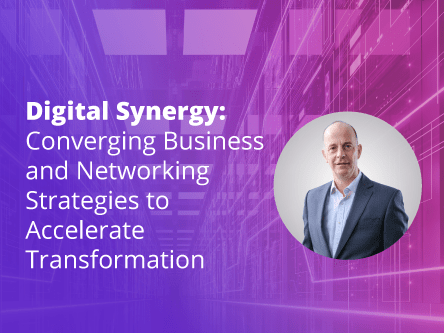The network and connectivity market requires high adaptability to keep up with the continuous change cycles of enterprise IT demands. This year will see even more change and growth in this space as new insights and technology developments emerge.
More companies are realising the need to bring added intelligence, security, and cloud capabilities to their overall business strategies – and there are more opportunities than ever to leverage on next-generation technologies to improve and evolve their business operations.
So, it is vital for service providers to stay up to speed with connectivity technology trends. They must also be flexible and adaptable in their approach to meet their customers’ needs, given the rapidly evolving demands.
Since hybrid working is not showing any signs of slowing, global networks and associated solutions need to be able to keep pace with the demands of remote connectivity. As a result, we can expect an even stronger focus on lowering latencies, boosting cloud capabilities, enhancing security, and automating decision making with Artificial Intelligence (AI).
Here are some key connectivity developments that are expected to drive the market for the rest of 2024:
- AI Integration
2023 saw a huge uplift in conversations and deployments of AI. From a networking perspective, 2024 will see an increase in opportunities for the integration of AI functionality into networks and solutions. This will increase the number of truly smart networks with autonomous controllers and programmable logic blocks for automated and intelligent decision-making.
A growing number of organisations will be investing more into AI and machine learning to further improve their intelligent network capabilities and fuel business performance. Smart software will strategically begin to guide networks and support businesses to achieve their goals.
- Cloud-Centric Networks
We can expect to see a growth in cloud-defined networking solutions or virtualised networking functions to support the ongoing and rapid adoption of multi-cloud. This growth will increase the number of acquisitions and mergers in this space.
Newer cloud networking providers are more likely to be funded or acquired this year. This is due to third party ‘in-cloud’ networking growing globally, as IT experts enhance cloud capabilities by re-engineering their networks and applications.
- Growth of Interworking Between Underlay and Overlay
The integration between overlay and underlay transport networks for technologies such as software-defined, wide-area networks (SD-WAN) will be a focal point for more companies this year.
SD-WAN can go hand in hand with legacy Multi-protocol Label Switching (MPLS) networks or enable MPLS to be fully replaced with Ethernet or Broadband Internet. It ensures similar Quality of Service (QoS), reduced complexity and increased cost-efficiency, whilst providing more control to the enterprise itself.
SD-WAN overlayed on low-cost broadband internet may not be the best option for some enterprises, especially those running a complex multi-cloud, multi-site network. However, Direct Internet Access or Ethernet underlays are great cost-effective options that can seamlessly cope with varying levels of application and user experience performance requirements.
We can expect a rise in networking solutions that can support both public and private cloud services across different locations, with a reliable underlay and flexible network infrastructure. With this growth, more enterprises will also be tailoring their architecture based on their mission-critical applications, business objectives and cloud strategies.
- 2FA and SASE Continue to Rise
One security function which is likely to continue to grow in use by consumers, and also businesses, is Two-Factor Authentication (2FA). As security breaches become more common, it is now more crucial than ever to add additional security layers onto business applications, portals and platforms.
Secure Access Service Edge (SASE) components are also becoming more advanced. SASE combines security functions and SD-WAN together in a single network fabric, using cloud-native security features such as secure web getaways, zero-trust network access and firewalls. There will be an increase in SASE options offered by different providers, so more enterprises will need to focus on understanding this approach and how to utilise it in their organisation.
We will also continue to see the merging of SD-WAN and Security services as they both meet in the middle to deploy singular deployment options.
- Optimising Networks for Hybrid Work
With hybrid workforces seemingly here to stay for the near future, this is likely the year that companies will commit to re-engineering their network architectures to account for less bandwidth use in the office if they haven’t already. Additionally, they will continue to simultaneously grow their unified communications strategies to ensure the success of remote workforces. Seamless and secure connectivity will be at the forefront of their business plans. As a result, we will also continue to see the explosion of service features provided by the unified communications companies, which in turn will drive more complex commercial packages on offer.
Furthermore, with cloud continuing to become the centre of the network universe, businesses will need to take a security-first approach and develop an application-oriented architecture to ensure smooth connectivity between offices, users and devices.
- Far-Reaching Clouds
For many cloud providers, 2024 will bring about further geographical expansion to areas such as Indonesia, the Philippines, and South Africa, to name a few. Some cloud providers have already started to enter hard-to-reach but digitally emerging destinations like these, so we can expect even more to follow.
On top of this, a growing number of on-premise cloud technologies will be explored. This will involve the ability to complete local cloud deployments in third-party data centres or owned premises. This form of cloud edge computing will help to boost user experiences (UX) globally, extending cloud data closer to where it is being consumed.
Next-Gen Networking
Today, hybrid enterprises can easily transform their operations with intelligent networking and advanced cloud computing. This will enable them to benefit from improved performance, stronger security and reduced capital and operational costs.
The year ahead will provide a multitude of exciting opportunities for both enterprises and service providers. Service providers can enhance their existing solutions set, and offer new solutions to their enterprise customers in response to evolving demands. In turn, enterprises can push their business forward with performance and efficiency improvements through next-generation technologies.
Intelligent underlay and overlay network integration, plus enhanced cloud capabilities, security, automation and AI, will drive transformational connectivity and take businesses to new heights with growing success.







